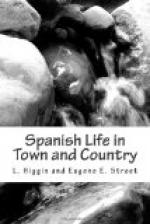El Correo is Liberal, of the special type of Sagasta, the present Prime Minister. El Espanol, which also gives one the impression of independence, is Liberal after the manner of Gemaro. El Heraldo, calling itself Diario Independente, is credited with being the Liberal organ of Canalijas. El Liberal and El Pais are Republican, and El Correo Espanol is Carlist, or clerical. This paper appears to be looked upon a good deal in the nature of a joke by its colleagues, and quotations from it are always accompanied by notes of exclamation.
La Correspondencia de Espana is a paper all by itself, an invention of Spanish journalism, and its unprecedented success is due to many of its quite unique peculiarities. Its originator, now a millionaire, is proud of relating that he arrived in Madrid with two dollars in his pocket. He it was who conceived the brilliant idea of founding a journal which should be the special organ of all. “Diario politico independiente, y de noticias: Eco imparcial de la opinion y de la prensa,” he calls it, and the fourth page, devoted to advertisements, would make the fortune of ten others. His boast was that it had no editor, paid no writers, and employed no correspondents. It simply possessed a certain number of “caterers” for news, who thrust themselves everywhere, picking up morsels of news—good, bad, and indifferent, for the most part scribbled in pencil and thrown into a receptacle from which they are drawn in any order, or none, and handed to the printer as “copy”; coming out in short, detached paragraphs of uneven length, ranging from three lines to twenty. Extracts from foreign newspapers, official news, provincial reports, money matters, religious announcements, accidents, everything comes out pell-mell—absolutely all “the voices of the flying day,” in Madrid and everywhere else, in one jumble, without order or sequence, one paragraph frequently being a direct contradiction to another in the same sheet. There are three editions during the day, but the “Night-cap,” which sums up them all, appears about ten o’clock or later, and it is scarcely an exaggeration to say that it is bought by almost every householder in the city.
The nature of the Correspondencia has changed very little since its earliest days. It is a little more dignified, condescends even to short articles on current subjects of interest, but it is the same universal provider of news and gossip as ever. It goes with the times; so far as it has any leanings at all, it is with the Government of the hour; but it is for the most part quite impersonal, and it makes itself agreeable to all parties alike. Santa Ana, the clever initiator of this new and highly successful adventure in journalism, has two other very prosperous commercial enterprises in his hands—the manufacture of paper for printing and the supply of natural flowers. He himself is an enormous and indefatigable worker, personally looks after his various businesses, especially the Correspondencia, and, mindful of his own early difficulties, he has created benefit societies for his workmen.




